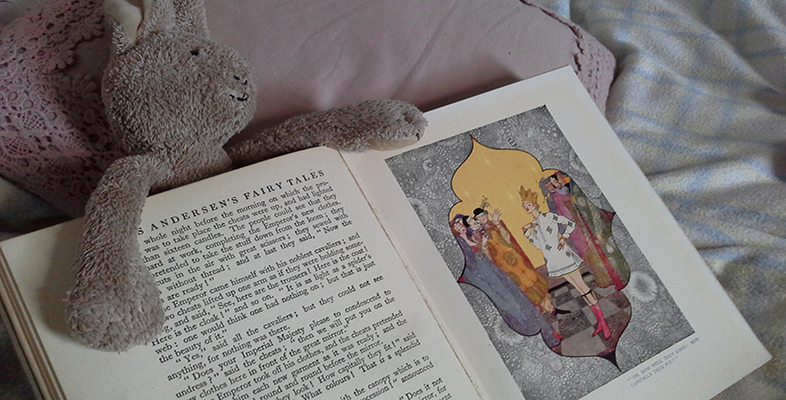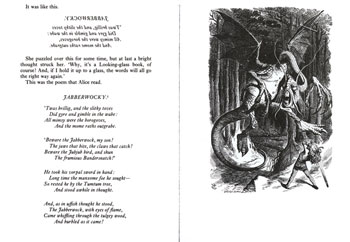6.1 Interpreting Alice
Illustrations may play a particularly important role in children’s fiction because of its often fantastic and improbable subject matter. Alice in Wonderland again provides us with a good example of this. You may recollect some of the following words that occur at the beginning of Carroll’s famous poem ‘Jabberwocky’, which appears in the novel:
’Twas brillig, and the slithy toves
Did gyre and gimble in the wabe;
All mimsy were the borogoves,
While it is possible to gain some meaning from the verbal text of Lewis Carroll’s poem ‘Jabberwocky’ despite the fact that it consists mostly of newly invented words, it would be very difficult to describe exactly what the Jabberwock looks like based only on the details given in the verbal text.
Activity 9
Part 1
Look at the first four stanzas of the poem, and highlight the words used in it to describe the Jabberwock itself. For words that are in standard English, use the first highlighting tool (by clicking on the yellow button and then highlighting your chosen words). For words that are invented words, use the second highlighting tool (by clicking on the green button before highlighting them). There are six words or phrases to highlight in all.
Answer
Part 2
Based on this slight description, what do you imagine the creature would look like? The image below is how John Tenniel, the book’s original illustrator, portrayed the scene described in ‘Jabberwocky’.
Is Tenniel’s representation similar to how you imagined it from your reading of these lines of the poem? Point the mouse cursor at different parts of the image to reveal details from the poem that Tenniel has included in his illustration.
Discussion
The image shows John Tenniel’s illustration of the Jabberwock from Chapter 1 of the book Through the Looking-glass. It is a black-and-white engraving which is very densely drawn and atmospheric. Emerging from a dark wood of tall straight trees with thickly tangled upper branches is a strange and gigantic creature. It is dragon-like, with scales, a long tail and two large bat-like wings on its back. It is moving forward on two hind legs that resemble those of a giant turkey. It seems to be half flying, half leaping. Its two huge forelegs are held in front of its body, and from the ends of each are four long vicious-looking talons. Two long, wavy antennae emerge from the top of its head, above glaring bulbous eyes. A pair of catfish-like feelers straddles each side of its snarling mouth. The teeth are large and rabbit-like. Its neck is long and serpentine, and extends out in front of the creature at around shoulder-height. In the bottom right part of the illustration is a young man who is standing with his back to the viewer, his legs apart, wielding a large sword. He has long fair hair and is dressed in doublet and hose. He is small in comparison to the creature, reaching around the height of its knee.
When the mouse is passed over five specific areas of this image, a text box is revealed, each containing the following phrases: jaws that bite, claws that catch, eyes of flame, tulgey wood, vorpal sword.
The rest of the image is Tenniel’s own interpretation of the scene. For example, the scale of the creature, which completely dwarfs the diminutive protagonist, is part of this interpretation. In this respect, the image uses similar techniques to those you saw in Section 1, where you came across images in which Molly Bang had manipulated size and positioning of shapes to suggest a particular interpretation. The creature’s shape is also part of the interpretation, as are its various features and its position in the composition. In this way, the raw ingredients are blended to create an image that both complements the verbal text but also extends its meaning.
Below is the poem ‘Jabberwocky’ as it appears on the page of the original text. Although the poem is often taken out of context, as you can see, it occurs in the narrative alongside the illustration and as part of the wider narrative.
One important aspect from the original context, for example, is that the first stanza is first printed backwards, but Alice then reads it by holding it up to a looking-glass. This element is lost if the poem is taken out of its original context, as is the added meaning and interpretation that comes from the illustration itself. In this example, therefore, we can see that the combination of word, image and context all contribute to the overall effect of reading the text.

